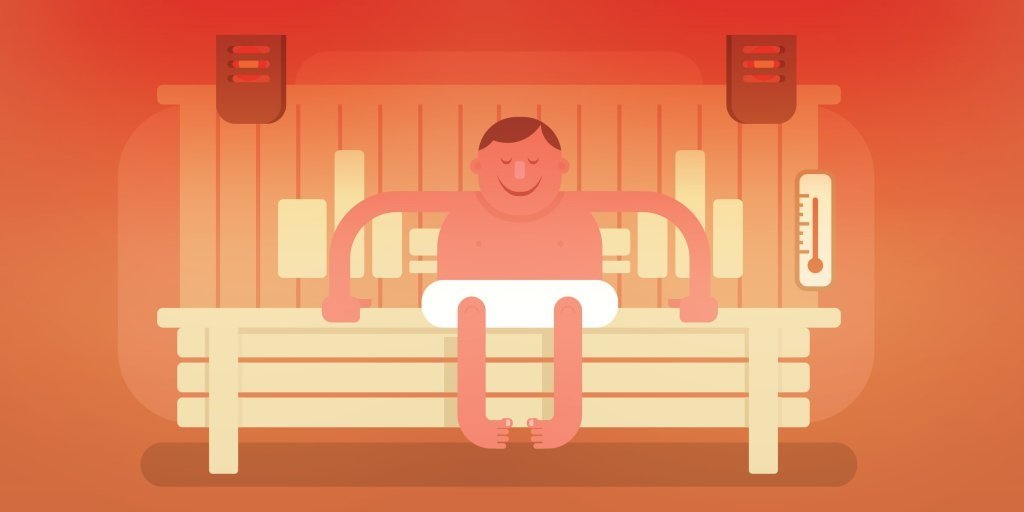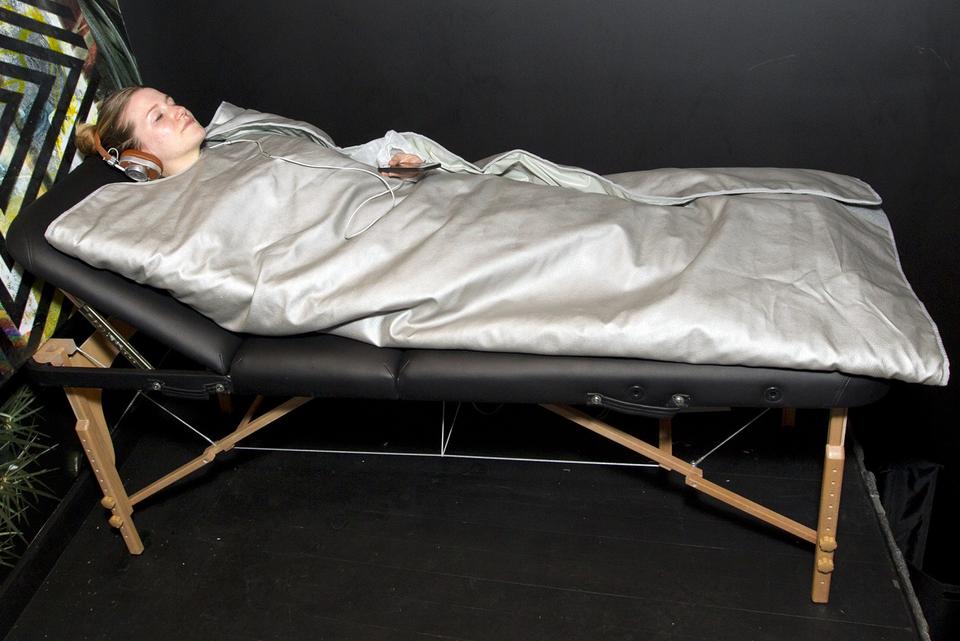So, what a healthy infrared sauna temperature should be?
The perfect temperature for an infrared sauna is between 110°F to 130°F. Lower temperatures may help with detoxification. Higher temperatures stimulate sweating which is beneficial for cleansing (cathartic)!
The real question is…
Do infrared saunas really live up to its hype?
While many users can attest to its beneficial effects, an equally vocal number of people remain skeptical. If you’re part of the latter, some of these questions might be plaguing your mind:
- Do they really truly help with weight loss?
- Can they detoxify the body?
- Are they more efficient than a conventional sauna?
All of these queries are entirely understandable, so let’s answer them in the best way possible – through scientific evidence.
What’s the Infrared Sauna?
As the name suggests, this type of device uses infrared (IR) heat over steam. While “infrared” might be dangerous to some, it’s actually the complete opposite:
- Natural infrared comes from the sun, and unlike UV rays, they usually don’t impart harm from prolonged exposure.
- You can expose yourself to infrared lighting for many hours with zero adverse effects.
- This type of heat is so safe that even hospitals use it to warm their newborn infants.
There are currently no reports of these machines giving adverse effects. However, there are a few cautions that go with any use of these devices.
For example, there are possibilities of dehydration, overheating, and medication interference.
People who have heart disease, are pregnant, or are intoxicated with alcohol or drugs are discouraged from using traditional saunas in general.
Summary: IR heat is safe. And the potential dangers that come with sauna use can easily be remedied by being prepared and knowing your medical background.
Infrared Sauna Benefits And Disadvantages
Dr. Ron van der Ploeg, who is a plastic surgeon, explains why there is a risks associated with infrared sauna benefits and disadvantages and reminds us that there is no way to tell the extent of the sauna benefit based on one sauna experience. He describes the challenges of adopting a hot sauna in a new clinic setting. At the start of the week, Dr. Ron van der Ploeg gives his advice to patients who are thinking about getting an infrared sauna. He describes the pros and disadvantages and reminds us that there is no way to tell the extent of the sauna benefit based on one sauna experience. He describes the challenges of adopting a hot sauna in a new clinic setting.
At the start of the week, Dr. Ron van der Ploeg gives his advice to patients who are thinking about getting it. He describes its pros and disadvantages and reminds us that there is no way to tell the extent of the sauna benefit based on one sauna experience. He describes the challenges of adopting a hot sauna in a new clinic setting. Do you have the same core questions that you had when you first learned about them? Learn why these pros and disadvantages may differ from one sauna session to the next and how to keep in the know. The initial question is, “Are they a great alternative to traditional steam and hot tubs?” In other words, do they have the same pros? According to the experts at Aura Health, they are not the same. “Some benefits might be better than some pros. You can’t jump from bed to bed and compare it,” said Ron van der Ploeg, who is a plastic surgeon. “I often hear the concern that they are used as a placebo so that people go to a sauna and they get a better feeling or they feel good.” Of course, many people who use them are looking for detoxification, anti-aging, pain relief, or simply little more energy.
Why Do I Feel Worse After Sauna?
As a general rule, sweating during sauna treatment reduces fluid retention in the body, which might bring relief, but it does not directly address heart disease. If you are sweating a lot during the sauna, that is good. If you are not sweating much, it is better to not sweat at all. Less is more. If you feel sweaty, use a towel to absorb some of the sweat. Then apply the following program to bring your body back to a normal metabolic state after your sauna session.
The main point is that the sauna usually does not address all of your health problems. If you think you have cardiovascular disease, your primary care doctor should be your first line of defense. Get a complete blood count or CBC. A CBC measures the levels of most vital blood-related molecules. Check your LDL cholesterol. The ratio of good cholesterol to bad cholesterol is a good measure. Your doctor can order this test for you. Check your blood pressure at least once a year. This test is also a good gauge for heart disease risk. It’s difficult to calculate blood pressure without a meter, and I strongly recommend you get a meter before using a sauna.
How Long Should You Stay in an Infrared Sauna?
After you start to break a sweat, 20 to 30 minutes is recommended. After acclimating to infrared heat, the average can be increased to 45 minutes. Two daily sessions is enough if you have a specific therapy goal. It is important to stay hydrated!
Here’s my recommended infrared sauna procedure that you can take to ensure your safety when using this device:
- Consult with your doctor about using it before anything else.
- Once you get the go-signal, start out with 1 session that lasts 15-20 minutes over the course of a week.
- Slowly work your way up to 45-minute sessions every day or every other day.
Most users report that 3-4 sessions a week that last half an hour are enough to give the most benefits. You don’t have to use a sauna twice a day to notice the effects. In fact, it overuse might even do you more harm than good.
For the best-infrared sauna models overview click here.
Summary: Before you use these devices, consult with your doctor first and start slow with short sessions and gradually increase the frequency as you get used to it.
What Temperature Should an Infrared Sauna Be Set at?
The ideal temperature is 110°F to 130°F. Lower temperatures may help with detoxification. Higher temperatures stimulate sweat production which is beneficial for cathartic (cleansing)
An IR unit doesn’t reach a temperature as high as a steam one, because the latter needs to produce more heat (160° – 200° Fahrenheit) to be effective.
Their IR counterparts, on the other hand, provide much gentler heating (110°-130° degrees Fahrenheit or 43.33°-54.44° Celsius).
The air temperature supports a sweating environment, but it is not what causes you to sweat. Also, remember that you will sweat much more in a traditional sauna than in therapy!
Summary: With lower recommended temperature, you get a gentler and safer way of detoxifying and losing weight.
Best Infrared Sauna Temperature for Weight Loss
What’s a good temp for Weigh loss in the sauna?
Well, as long as you keep to the optimal temperature range, you are good to go.
Remember, the fact is that receiving IR heat is more important to weight loss than the temperature setting. And why?
Toxins in our bodies are usually fat-soluble. So when whenever we sweat, we only excrete a minuscule amount of toxins because sweat is water-based. But with IR heating, the fat cells in our body are targeted, and more toxins are released.
Summary: With an IR sauna, the temperature of a sauna doesn’t matter as much. Just keep within the recommended temp safety limits, and you’re all set.
Frequently Asked Questions:
Do Infrared Saunas Really Detoxify Your Body?
Yes and no. While there have been studies that point towards steam saunas as detox machines, the amount of toxic material we sweat out is minimal.

- The Environment International journal has a published report that shows how sweat excretes environmental pollutants in minuscule amounts.
- Small amounts of BPA and heavy metals can be found in sweat since these materials dissolve better in water.
While the effectiveness of removing pollutants when using these devices has yet to be studied, there are numerous findings where using IR saunas can help with chronic health problems like:
- congestive heart failure
- high blood pressure
- rheumatoid arthritis
- Alzheimer’s disease
- type 2 diabetes
- dementia
- Headache
Summary: While the scientific opinion on the detoxifying power of these machines is mixed, more and more scientists publish their findings on other potential health benefits.
What Are the Dangers of Infrared Saunas?
Any healthy individual can safely enjoy these machines. But if you’re experiencing one or more of the conditions below, consult a doctor first before trying them out:
- Overheating may cause heat attack or heat exhaustion
- Dehydration may be caused by insufficient liquid intake
- Drinking alcohol in a sauna is dangerous
- Toxins are mobilized in the bloodstream because of detoxification.
- Interference with certain medications
- If you’ve recently injured your body, do not use saunas because heat can promote severe inflammations even with minor sprains. However, we recommend that you talk with your doctor because some injuries can benefit from IR.
- Pregnant women should avoid the use of these devices in general unless under doctor’s orders or medical supervision.
- People who have conditions where they don’t sweat can be dangerous because not sweating in hot temperatures can easily lead to heatstroke and overheating.
- Don’t use these machines if you’re a hemophiliac or prone to getting hemorrhages.
Summary: People with conditions that aren’t fit for using steam-based devices are generally not allowed to use their IR counterparts as well.
Do Infrared Saunas Burn Fat?
Much like any other weight loss plan, you won’t be able to burn off much fat without proper diet and exercise. However, some studies point out that these machines can actually help you out.
One experiment conducted at Bingham University exposed subjects to these machines over four months, and they noticed a 4% fat loss when compared with the control group.
With that said, more research is needed to verify these results. The researchers didn’t take the participant’s exercise into account as well as their diet outside the confines of their study.
Summary: Initial studies show that using these devices do aid in weight-loss, but more tests need to be done to validate their effectiveness fully.
Should You Shower After Infrared Sauna?
An infrared sauna benefits the skin because it can help unclog your pores and remove trapped particles.
But that also means that your body will be dirty after using them, so it’s always a good idea to take a shower afterward.
A quick body-temp rinse is enough to close your pores and leave your body smooth and clean.
Summary: Showering after a session is recommended in order to remove the sweat and grime on your body.
How to Replace Electrolytes After Sauna?
The most prevalent mistake people tend to make whenever they use these devices is not drinking the ideal amount of water.
And hydration is crucial because a sauna removes a lot of moisture from our body. Here are a few guidelines to keep you hydrated:
- Treat sauna visits like an intense workout, so you should be drinking more than you would on a regular day.
- One liter for every session is generally the recommended intake.
- If you’re thirsty after using it, then you didn’t drink enough water beforehand.
Summary: Drink plenty of water pre and post infrared sauna to replace your lost electrolytes and water.
How to Use Infrared Sauna Blanket?
If you want to know how to use a sauna at home (link), this blanket is the answer. Using a blanket benefits individuals who don’t have easy access to spas or gyms. So here’s a simple guide on how to use them:
- Plug the device into a power source.
- Set the time and the best temperature for the sauna Celsius (remember that a high heat infrared sauna doesn’t necessarily impart stronger effects, so keep it at a safe temp.)
- Step into the blanket and seal it up.
Summary: An IR blanket is the solution that gives you easy access to an IR sauna morning or night
Is it OK to Sit in an Infrared Sauna Every Day?
The perception is that sweating reduces toxins and clears the body. But is it really as important as a doctor might say? Should you be sitting in an infrared sauna all the time? It’s possible that sitting in the heat could be beneficial for some people, but it is also possible that it’s unhealthy. Most of the research on heat therapy, including infrared sauna use, has been done in people who are battling serious illnesses. Some studies suggest it can speed the recovery of patients with cancer. But there have been no studies to look at the health benefits of infrared sauna use for healthy people.
So there are some concerns that the misconception that using an infrared sauna can improve health could be putting people at risk. The bottom line is that most research on heat therapy shows no real health benefits, so there’s little reason to bother with it. Most of the research that has been done with healthy people h been on people with cancer and none of the studies show that people who use infrared saunas live longer. But there are many other health benefits of an active lifestyle, which are great reasons to stick to a healthy routine.
How Long Should You Be in an Infrared Sauna?
Depending on the model, a true infrared sauna can take 20 to 30 minutes to heat up, and users can stay in the sauna for as long as they want. But each brand of infrared sauna is more suited to specific users. The infrared sauna I purchased for home use was a full-size model that can reach a sauna temperature of 103.4° Fahrenheit.
The heater uses electric-compressor technology to pump and direct the heated water into the sauna. There is no gas involved, so there’s no harmful odor or carbon monoxide. The metal construction makes it extremely durable, and it includes a removable insulated hood. According to Goop, the sauna’s benefits are numerous, and they include “reduced stress and anxiety, increased energy, mental clarity, and sleep.” What’s more, the maker of the product claims.
Should I Take a Shower After Infrared Sauna?
It might seem silly, but your body temperature could vary from the warmer showers you take in the morning to the cool ones you take in the afternoon. If your temps fluctuate so much, you should opt for a longer, hotter shower in the morning, Dr. Talhelm said. But just because a treatment lasts longer doesn’t mean it’ll work any better, Dr. Talhelm added. “Some people actually tend to end up with decreased blood pressure when using infrared saunas, and I have not seen any data on that,” she said. But in general, Dr. Talhelm recommended infrared saunas for people who want to detox and practice natural detoxification, for example, from toxins in the skin, or from alcohol consumption.
There’s a lot of misinformation on the Internet about the safety of using infrared saunas to get rid of your skincare woes. First, this isn’t a pseudoscientific salon cleanse that will obliterate your acne. A common misconception is that cold temperatures or exposure to infrared rays from the sauna are the main treatments, but that’s not true. The body heats up to between 50-53 degrees Celsius in most saunas. A balmy warm 40-45C is fine. Many people with oily skin also have dry skin, so it’s wise to shower before you sit in a sauna. The heat from the sauna may dry out and irritate your skin.
Can You Overheat in an Infrared Sauna?
Yes, it is possible to overheat in an infrared sauna. While infrared saunas operate at lower temperatures compared to traditional saunas, typically ranging from 120 to 150 degrees Fahrenheit (49 to 65 degrees Celsius), prolonged exposure to these temperatures can still lead to overheating, especially for individuals with certain health conditions or those who are particularly sensitive to heat.
The human body has mechanisms to regulate its internal temperature through processes like sweating and vasodilation. When exposed to high temperatures, these mechanisms work to dissipate heat and maintain a stable internal temperature. However, if the body is unable to effectively regulate its temperature, overheating can occur.
Factors that can contribute to overheating in an infrared sauna include dehydration, insufficient ventilation, and pre-existing health conditions such as heart disease or high blood pressure. Dehydration can impair the body’s ability to sweat and cool down, while poor ventilation can lead to a buildup of heat within the sauna enclosure. Individuals with cardiovascular issues may be more susceptible to overheating due to the sauna’s effects on heart rate and blood pressure.
Symptoms of overheating in an infrared sauna may include dizziness, nausea, rapid heartbeat, and fainting. If any of these symptoms occur, it is important to exit the sauna immediately and cool down using methods such as drinking water, resting in a cooler environment, and applying cold compresses to the skin.
To prevent overheating, it is crucial to use an infrared sauna responsibly and to listen to your body’s signals. Limit sessions to recommended durations, typically around 20 to 30 minutes, and ensure adequate hydration before, during, and after sauna use. Individuals with underlying health conditions should consult with a healthcare provider before using an infrared sauna to determine if it is safe for them.
In conclusion, while infrared saunas offer various health benefits, including relaxation and detoxification, it is essential to be mindful of the risk of overheating and take appropriate precautions to ensure a safe and enjoyable sauna experience.
Final Thoughts
More and more studies are being conducted on the benefits of using them. And while these findings are far from conclusive proof, it’s certainly a step in the right direction. Always remember to consult with your doctor before you try them out.
If you don’t have the budget for buying these expensive machines, many spas and gyms can rent out their units for a smaller price.





